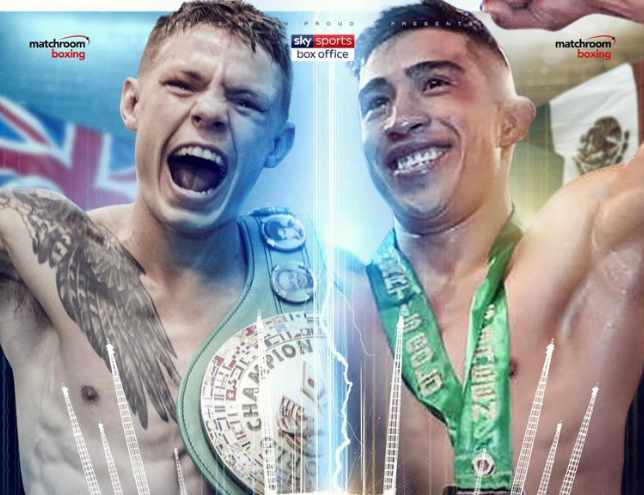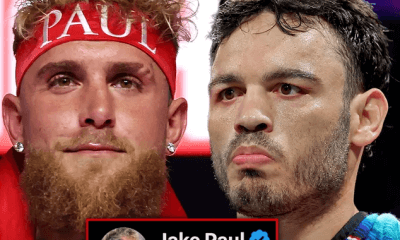Featured Articles
Three Punch Combo: Edwards vs Martinez, Juan Francisco Estrada and More

Three Punch Combo: Edwards vs Martinez, Juan Francisco Estrada and More
London’s O2 Arena will be the host of the most noteworthy bout this weekend when WBA/WBO lightweight champion Vasiliy Lomachenko (13-1, 10 KO’s) faces off against Luke Campbell (20-2, 16 KO’s). In addition to both of Lomachenko’s lightweight title belts being at stake, the vacant WBC belt will also be on the line. While this fight will be grabbing most of the headlines this week, another title fight on this docket may ultimately steal the show.
Charlie Edwards (15-1, 6 KO’s) will make the second defense of his WBC flyweight title when he faces mandatory challenger Julio Cesar Martinez (14-1, 11 KO’s). While Edwards will be favored, this fight appears to be fairly evenly matched and the contrasting styles should make for an entertaining scrap.
Edwards is a classic boxer-puncher by trade. When watching him fight, his fluidity stands out. His movements and punches just seem to flow so naturally.
While he is frequently in constant motion with his feet, Edwards is also a volume puncher who prefers to lead and is often firing off combinations with his quick hands. He is good at using just the right precise angles to find ways to land clean power shots to the head as well as body of his opposition. While this style does tend to be vulnerable to counters, Edwards has shown excellent head movement and reflexes to often evade those counter shots.
As his record indicates, Edwards is certainly not a heavy-handed puncher. But he is sharp and crisp with his punches, so while he may not score a ton of knockouts, he generally earns his opponent’s respect.
Julio Cesar Martinez, a pressure fighter by nature, likes to come forward pressing the action from the opening bell. Similar to Edwards, Martinez likes to lead and also is a volume puncher. While coming forward, Martinez will be winging punches from all angles while generally placing a particular emphasis on attacking his opponent’s body. These punches are often wide and easy to counter, but Martinez is not concerned with getting hit by a few shots. And unlike Edwards, he possesses heavy handed power, and in both fists.
One quirk I have noticed when watching Martinez is that he often switches stances from orthodox to southpaw. When doing so, he is not in a position to punch and can leave himself in a vulnerable position.
I absolutely love this fight and think it could be a contender for fight of the year. These are high volume punchers who like to lead and the contrast of styles should help make for some exciting exchanges. Add in the fact that they appear to be evenly matched and we could get many rounds of sustained action. The ingredients are all there to make for one memorable fight.
Under The Radar Fight, Part Two
On Saturday, Fox will broadcast a tripleheader from the Minneapolis Armory in Minnesota that is headlined by a contest for the vacant WBA 154-pound title between Erislandy Lara (25-3-3, 14 KO’s) and Ramon Alvarez (28-7-3, 16 KO’s). While I am not a fan of this fight as I see it as a total mismatch in favor of Lara, there is a bout on the televised undercard that really piques my interest.
Fresh off an impressive knockout victory on ShoBox two months ago against then undefeated Hector Manuel Zepeda, rising 154-pound prospect Sebastian Fundora (13-0, 9 KO’s) returns to the ring to face Jamontay Clark (14-1, 7 KO’s). Clark was once considered a top prospect himself and should be a stern test for Fundora.
Nothing has changed in Fundora’s game since I wrote him up before that ShoBox appearance two months ago. Standing over 6’5” tall, Fundora is a high-volume puncher who delivers sharp accurate punches in combination. And he possesses heavy handed power in both of his fists. It is easy to see why many in boxing see him as a future champion and he showcased all his skills in dismantling Zepeda in that outing in June.
But there are aspects of Fundura’s game that need work. I love the fluidity with which he throws those combinations but he continues to display a major flaw when doing so. After he finishes punching, he tends to stand stationary for a moment with his chin exposed. He has gotten away with this flaw so far, mainly because he is hurting his opponent, but this needs to be corrected.
In addition, Fundora lacks any sort of head movement. Again, he has yet to pay for this flaw, but as his competition gets better, he is going to get hit clean unless he starts adding a little head movement to his game. As a matter of fact, I think Clark, who has very quick hands and quite a bit of athleticism, may be just the opponent to touch Fundora up some. True, Clark has struggled as his competition has risen, but the tools are still there and if he can put it all together, he can still make some serious noise in this sport.
I see this fight as potentially being much more competitive than most in the industry think. Clark’s speed and skill can potentially cause a problem for Fundora especially if Fundora still shows the leaks in the defensive side of his game. Make no mistake; Clark is a significant step up for Fundora and if Clark gains some confidence early, things could get really interesting.
Juan Francisco Estrada Has Unfinished Business
There was plenty of discussion about Juan Francisco Estrada (40-3, 27 KO’s) possibly looking toward unification fights following the successful defense of his WBC 115-pound title with a ninth round TKO of Dewayne Beamon this past Saturday in Mexico. While I am usually all for unification fights, there is still some unfinished business for Estrada before targeting those unification bouts.
In 2012, a then relatively unknown Estrada challenged pound for pound entrant Roman “Chocolatito” Gonzalez for Gonzalez’s 108-pound championship. What ensued that night at the Sports Arena in Los Angeles was an absolute classic between two very skilled combatants. After twelve rounds of all-out sustained action, Gonzalez wound up retaining his title with a unanimous decision that many thought could have gone either way.
Fans who watched that fight, either in person or on the fledging WealthTv where the fight was broadcast in the United States, clamored for a rematch that never materialized. As the careers of Gonzalez and Estrada continued to blossom, talks of a potential rematch would come up from time to time, but those talks would never go far.
It has now been seven years since that fight. Estrada is now the fighter on pound for pound lists. And while Gonzalez may not be at that elite level he once was, he certainly still has plenty left in the tank. A second encounter between these two is still mouthwatering as it would almost certainly be an all-action affair much like the first fight.
There is unfinished business between these two. Before Estrada turns to unification fights, he needs to settle the score with Gonzalez. This is a rematch that needs to happen and should be next on the agenda for both men.
Check out more boxing news on video at The Boxing Channel
To comment on this story in The Fight Forum CLICK HERE
-

 Featured Articles4 weeks ago
Featured Articles4 weeks agoAvila Perspective, Chap. 330: Matchroom in New York plus the Latest on Canelo-Crawford
-

 Featured Articles3 weeks ago
Featured Articles3 weeks agoVito Mielnicki Jr Whitewashes Kamil Gardzielik Before the Home Folks in Newark
-

 Featured Articles12 hours ago
Featured Articles12 hours agoResults and Recaps from New York Where Taylor Edged Serrano Once Again
-

 Featured Articles4 weeks ago
Featured Articles4 weeks agoCatching Up with Clay Moyle Who Talks About His Massive Collection of Boxing Books
-

 Featured Articles5 days ago
Featured Articles5 days agoFrom a Sympathetic Figure to a Pariah: The Travails of Julio Cesar Chavez Jr
-

 Featured Articles3 weeks ago
Featured Articles3 weeks agoMore Medals for Hawaii’s Patricio Family at the USA Boxing Summer Festival
-

 Featured Articles7 days ago
Featured Articles7 days agoCatterall vs Eubank Ends Prematurely; Catterall Wins a Technical Decision
-

 Featured Articles4 weeks ago
Featured Articles4 weeks agoRichardson Hitchins Batters and Stops George Kambosos at Madison Square Garden




















